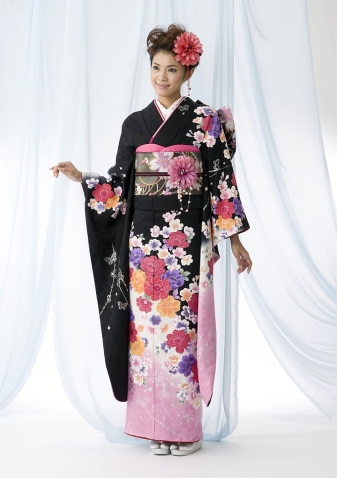KINOMOS


History
As the kimono has another name, gofuku (呉服?, literally “clothes of Wu (吳)”), the earliest kimonos were heavily influenced by traditionalHan Chinese clothing, known today as hanfu (漢服?, kanfuku in Japanese), through Japanese embassies to China which resulted in extensive Chinese culture adoptions by Japan, as early as the 5th century AD.[5] It was during the 8th century, however, that Chinese fashions came into style among the Japanese, and the overlapping collar became particularly women’s fashion.[5] During Japan’s Heian period (794–1192 AD), the kimono became increasingly stylized, though one still wore a half-apron, called a mo, over it.[5] During theMuromachi age (1392–1573 AD), the Kosode, a single kimono formerly considered underwear, began to be worn without the hakama(trousers, divided skirt) over it, and thus began to be held closed by an obi “belt”.[5] During the Edo period (1603–1867 AD), the sleeves began to grow in length, especially among unmarried women, and the Obi became wider, with various styles of tying coming into fashion.[5]Since then, the basic shape of both the men’s and women’s kimono has remained essentially unchanged. Kimonos made with exceptional skill from fine materials have been regarded as great works of art.[5]
The formal kimono was replaced by the more convenient Western clothes and yukata as everyday wear. After an edict by Emperor Meiji,[7]police, railroad men and teachers moved to Western clothes. The Western clothes became the army and school uniform for boys. After the1923 Great Kantō earthquake, kimono wearers often became victims of robbery because they could not run very fast due to the restricting nature of the kimono on the body and geta clogs. The Tokyo Women’s & Children’s Wear Manufacturers’ Association (東京婦人子供服組合) promoted Western clothes. Between 1920 and 1930 the sailor outfit replaced the undivided hakama in school uniforms for girls. The 1932 fire at Shirokiya‘s Nihonbashi store is said to have been the catalyst for the decline in kimonos as everyday wear. Kimono-clad Japanese women did not wear panties and several women refused to jump into safety nets because they were ashamed of being seen from below. (It is, however, suggested, that this is an urban myth.)[8][9] The national uniform, Kokumin-fuku (国民服), a type of Western clothes, was mandated for males in 1940.[10][11][12] Today most people wear Western clothes and wear the breezier and more comfortable yukata for special occasions.
In the Western world, kimono-styled women’s jackets, similar to a casual cardigan,[13] gained public attention as a popular fashion item in 2014.
HAKAMA
Hakama (袴?) are a type of traditional Japanese clothing. They were originally worn only by men, but today they are worn by both sexes.Hakama are tied at the waist and fall approximately to the ankles. Hakama are worn over a kimono (hakamashita)[citation needed].
There are two types of hakama, divided umanori (馬乗り?, literally horse-riding hakama) and undivided andon bakama (行灯袴?, lit., lanternhakama). The umanori type have divided legs, similar to trousers. Both these types appear similar. A “mountain” or “field” type of umanorihakama was traditionally worn by field or forest workers. They are looser in the waist and narrower in the leg.
Hakama are secured by four straps (himo): two longer himo attached on either side of the front of the garment, and two shorter himoattached on either side of the rear. The rear of the garment has a rigid trapezoidal section, called a koshi-ita (腰板?). Below that on the inside is a hakama-dome (袴止め)[citation needed] (a spoon-shaped component sometimes referred to as a hera) which is tucked into the obi or himoat the rear, and helps to keep the hakama in place.
Hakama have seven deep pleats, two on the back and five on the front. The pleats are said to represent the seven virtues of bushido, considered essential to the samurai way. Although they appear balanced, the arrangement of the front pleats (three to the right, two to the left) is asymmetrical, and as such is an example of asymmetry in Japanese aesthetics.





